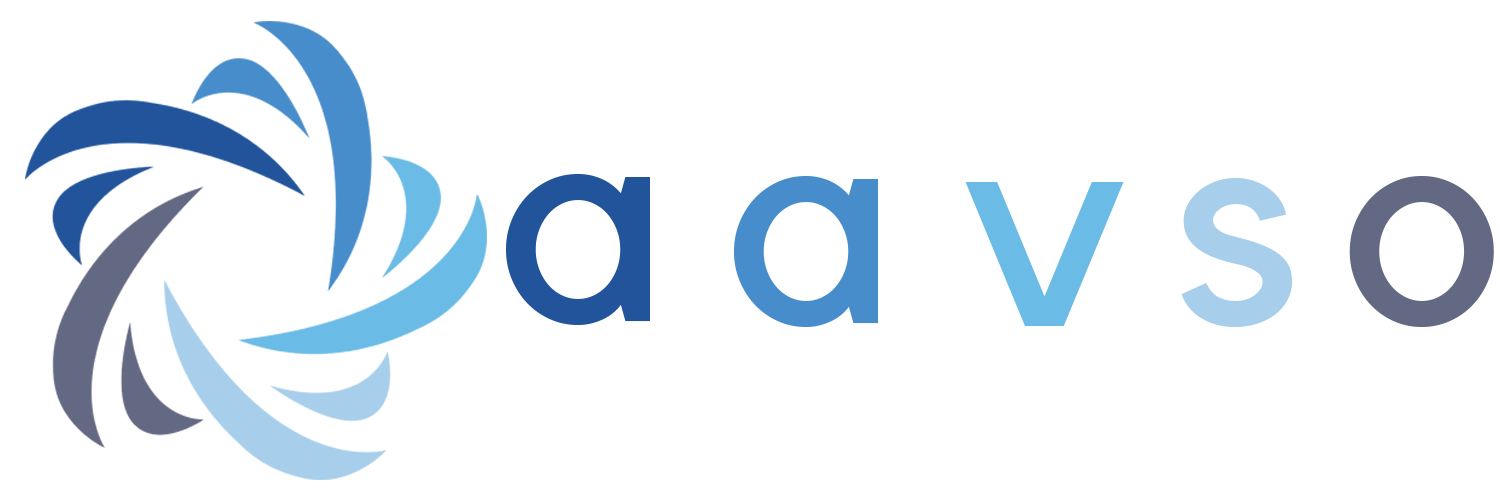Elections for AAVSO Board members are held annually prior to the Annual Meeting. Voting in this election is open only to AAVSO members in good standing.
Meet the Candidates Webinar: To give you the opportunity to meet the candidates online (via Zoom), we are hosting a complimentary webinar on Saturday, October 4, at 18:00 UT (2 p.m. ET). Pre-registration is required.
Voting Procedure
All AAVSO members in good standing as of September 30, 2025, who have an email address in their AAVSO profile will be emailed an invitation that day with a link to vote for new board members to fill the three vacancies. Electronic voting closes at 9:00 AM U.S. Pacific Time on Sunday, November 2.
All AAVSO members in good standing who do not have an email address in their AAVSO profile will receive a paper ballot and pre-addressed and stamped envelope to mail in their votes. Mail-in ballots must be received at AAVSO headquarters one week prior to the electronic voting deadline.
Questions? Please send us an email! Thank you for voting!
Slate of Candidates
- Isaac Ceballos, Porterville, California, United States
- Rick Diz, St. Simons, Georgia, United States
- Dipankar Maitra, Norton, Massachusetts, United States
- Peter Bealo, Plaistow, New Hampshire, United States
- Peter Craig, Charlotte, Michigan, United States
- Michael Rapp, Dickinson, Texas, United States
Candidate Statements
Isaac Ceballos
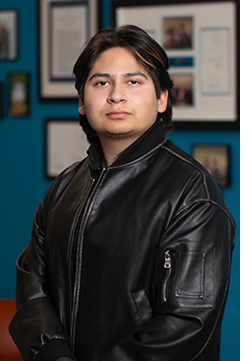
My name is Isaac Ceballos, and it would be an honor to join the AAVSO Board of Directors. For the past three years, I've been actively engaged with AAVSO as a non-member using the light curve database for my own research and advocating for its database use in community outreach. I want to help AAVSO be more accessible for the next generation of scientists, especially those who are underrepresented.
My background combines leadership, teaching, and research. I have experience in organizations like my college's SHPE chapter, where I established a club budget and launched initiatives that increased attendance at events. Through the Student Leadership Institute, I established service-learning projects and trained project volunteers. These experiences strengthened my governance and oversight abilities with a focus on citizenship engagement. My summer REU at Rochester Institute of Technology provided real-world experience with hands-on variable star research, where I led a flare monitoring project on EV Lacertae.
Additionally, I serve as one of the undergraduate coordinators for the RetroSkies Lab, a citizen-science project digitizing old sky plates. My responsibilities entail training volunteers, creating simple technical tools to facilitate entries, and managing support channels. From these experiences, I learned how to keep teams motivated, make data entry accessible, and establish
effective connections between contributors of all levels.
AAVSO's greatest strength is the archive of data, contributions to citizen science and amateur-professional collaboration. On the other hand, it can feel overwhelming to onboard new members. If elected, I'd promote more tutorials on Canvas/members spreadsheets/templates and templates for easier start points, as well as modernizing tools like Jupyter notebooks to make participation more accessible. I'd like AAVSO to become more accessible, inclusive, and forward-looking so that our history of contributions to science can continue on.
As a first-generation college student and young researcher, I offer a fresh perspective while still championing AAVSO goals. I am excited about any opportunity to lend my voice, assets, and skills related to leadership, teaching, research, and outreach to help AAVSO grow and thrive.
View Isaac's nominee questionnaire responses.
Rick Diz
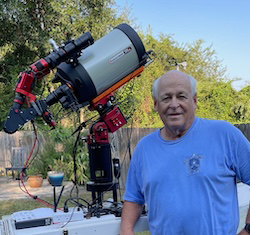
I am honored to be nominated as a candidate for the AAVSO Board of Directors. As members consider the various candidates, it seems appropriate for me to provide some details regarding my personal history, as well as my interest and activities in astronomy and the AAVSO.
From an early age I wanted to be a scientist. I earned a bachelor’s degree in biology at Duke University and then attended Northern Arizona University, earning a biology master’s degree. Later, I returned to graduate school at Virginia Tech earning an M.S. in Environmental
Engineering followed by a Ph.D in Civil Engineering. I joined the faculty of Gannon University in Erie, PA, and helped to form a Department of Environmental Science and Engineering, which I chaired for almost twenty years, retiring in 2017.
Over the course of my academic career, I authored numerous grant proposals, many of which were funded (totaling more than $900,000), while some were not. These included both institutional grants as well as research grants. On several occasions I was invited by the National Science Foundation and the US Environmental Protection Agency to serve as a peer-reviewer of proposals by others in my field. I have authored numerous papers in peer-reviewed journals as well as reports to funding agencies. I have presented papers at environmental science and engineering conferences and have served as a peer-reviewer for journals in the environmental field.
Over many years I taught undergraduate and graduate students, mentoring many of them in their senior or graduate thesis projects in the field of water quality and water treatment. I provided workshops for local business leaders who were interested in water quality in the Great Lakes, climate change, biofuels from waste materials, and pollution control. While living in Erie, I became involved in the community, serving on advisory boards and boards of directors.
Upon retirement in 2017, we moved south, and I was eager to find a new field in which I could continue to conduct scientific study. I had an early interest in astronomy (from high school days) and so I put together a backyard telescope system and became a student all over again. I discovered the AAVSO and found a welcoming and supportive community. I learned how to do photometry and contributed observations to the AAVSO’s database. I was then attracted to spectroscopy, where I have focused my efforts over these past several years. I have contributed spectra to AVSpec, the BAA spectral database, and the BeSS database. I have given oral presentations on my work at the 2022, 2023, and 2024 annual AAVSO meetings, and most recently, at the June 2025 meeting of the Society for Astronomical Science in Ontario, California. I am published in the JAAVSO. I am an active contributing member of the AAVSO Spectroscopy Section.
Why do I want to be elected to the Board? The AAVSO has a long and valued role of providing service to the astronomical community and I would like to contribute to its success. The stewardship of the AAVSO databases is the most central mission of the organization. These databases have a long and storied history and must be extended and maintained at a high level of credibility, accessibility, and reliability. But that is not the only mission to be shepherded. AAVSO has become an important avenue for would-be citizen astronomers like me to find educational support as well as an avenue to connect with like-minded others. In this time of great change, we face challenges to being excellent in that role. To succeed, we will need to be creative, imaginative, and willing to embrace new ways of doing things.
Some ask, what does the AAVSO not do so well? Being a relatively new member (about five years), I know it can be quite intimidating for new and prospective members. The current leadership recognizes that we need to do a better job of overcoming that perceived barrier. No one wants to appear foolish or make some embarrassing mistake. To address this, new ways of breaking down those real or perceived barriers should be found, leading to integrating new members into the life of the organization as painlessly as possible. Awareness of this is included in the new Strategic Plan, and progress in this regard is already underway. We must be ever more pro-active in making the organization friendly to prospective/new members.
The Strategic Plan is an impressive document created by the Planning Committee, the executive director, and the board. It includes a path forward with a clear action plan. I believe that all members need to help translate that plan into reality. If elected to the board, it would be my duty to do so.
View Rick’s nominee questionnaire responses.
Dipankar Maitra
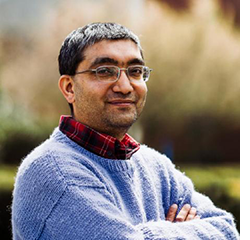 An astrophysicist by training and an amateur astronomer at heart, Professor Dipankar Maitra works with students and collaborators around the world on understanding what happens near black holes and neutron stars. He is especially interested in understanding the coupling between accretion inflows and relativistic outflows near these objects. Lately he has been interested in optical polarization studies of the solar corona and other astronomical bodies as well.
An astrophysicist by training and an amateur astronomer at heart, Professor Dipankar Maitra works with students and collaborators around the world on understanding what happens near black holes and neutron stars. He is especially interested in understanding the coupling between accretion inflows and relativistic outflows near these objects. Lately he has been interested in optical polarization studies of the solar corona and other astronomical bodies as well.
Professor Maitra earned his PhD from Yale University and did postdoctoral stints at the University of Amsterdam and the University of Michigan before joining the Physics & Astronomy faculty at Wheaton College in Massachusetts.
He is constantly searching for better ways to involve students and amateur astronomers in astronomical research, and to make physics and astronomy classes more welcoming and inclusive. He uses telescopes in Wheaton’s on-campus observatory and other ground-based remote telescopes, as well as space-based optical, UV, and X-ray telescopes, for his teaching and research.
View Dipankar's nominee questionnaire responses.
Peter Bealo
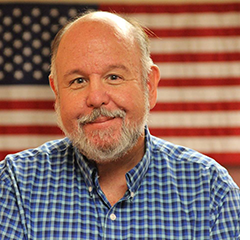
I have been an amateur astronomer for over 50 years. During that time, I was President of Amateur Telescope Makers of Boston (ATMoB) for two years. I have been an AAVSO member for six years, and have ~57,000 measurements in the database, all using AAVSONet instruments. I am the Instrumentation and Equipment SIG Lead, have participated on the Strategic Plan Committee, Cost Saving Committee and several other committees, I wrote several fundraising letters. Over the last several years I represented AAVSO twice at NEAF, Chaired two AAVSO-centric sessions at Stellafane and have given numerous AAVSO presentations to astronomy clubs. Over the years, I have done a lot of work in public outreach and education. I am the observatory manager for the Timberlane Regional School District Observatory in Plaistow, NH and am the Executive Secretary of the Antique Telescope Society.
Professionally, I enjoyed working for 40 years in the semiconductor and semiconductor capital equipment industries in engineering, marketing, and project management roles, taking new ideas from white board to finished products using matrixed teams of diverse personnel was my specialty. I continue to perform data analysis and business continuity consultation to various organizations.
I also volunteer for AARP TaxAide doing free tax preparation for anyone needing help, and am on my town’s Energy and Elder Affairs Committees. In the past I have been a member and Chair of my local public School Board, a member of the school district and town budget committees and the long time Chair of our Zoning Board of Adjustment.
I am proud of the work the Board and staff has done in preparing AAVSO to succeed over the next decades. We have done a lot of work, but there is still much to be done. There is a place for AAVSO, but we must regain financial stability to survive. Presently, annual dues only cover about 10% of our annual expenses, and we need to find a way to cover more. In the recent past, our conferences, attended by less than 10% of our members, consumed well over half of the total annual dues, now that we recognize this, we are striving to limit this expense while still providing excellent conferences. The first step in solving any problem is recognizing there is a problem!
View Peter's nominee questionnaire responses.
Peter Craig
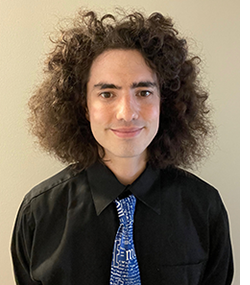
I am a postdoc at Michigan State University studying the bolometric light curves of classical novae. My group aims to understand both the shape of these light curves, and how often novae show signatures of shocks or other sources of additional luminosity
If elected, I will help improve the synergy between AAVSO observations and large sky surveys and other research activities. One of the best ways to maximize the scientific return of AAVSO data is to have a clear plan of which sources are the most in demand of data scientifically, so that observers have the option to pick the best sources to monitor in terms of scientific output. This will involve keeping tabs on the LSST alert streams (and other large-sky surveys) to identify good transient targets for high cadence observations. Given the low-ish cadence of LSST at one image every 3 days, there will be a need for fast, high-cadence follow up of the many new transients expected to be captured by LSST. These kind of targets allow for AAVSO to use the strengths of citizen science observing campaigns to continue producing data sets with large scientific value.
View Peter's nominee questionnaire responses.
Michael Rapp
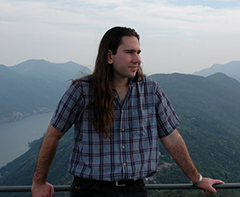 My involvement with the AAVSO over the past thirteen years has been some of the most fun and fulfilling time of my thirty-plus years as an amateur astronomer. I am primarily a visual variable star observer (and will always champion that), but also keenly interested in smart telescopes and how we can leverage those to engage current and future members. I have had a twenty-seven-year career in public higher education in which I have extensive experience in protecting the integrity and availability of scientific data and leading projects with procurements of half a million dollars. Moreover, I have thirty years of experience in academic publishing and conference administration. This is a time of great challenge for our organization, but challenges beget opportunities. We have existed for 114 years. Nothing would give me more joy than to continue to help us thrive.
My involvement with the AAVSO over the past thirteen years has been some of the most fun and fulfilling time of my thirty-plus years as an amateur astronomer. I am primarily a visual variable star observer (and will always champion that), but also keenly interested in smart telescopes and how we can leverage those to engage current and future members. I have had a twenty-seven-year career in public higher education in which I have extensive experience in protecting the integrity and availability of scientific data and leading projects with procurements of half a million dollars. Moreover, I have thirty years of experience in academic publishing and conference administration. This is a time of great challenge for our organization, but challenges beget opportunities. We have existed for 114 years. Nothing would give me more joy than to continue to help us thrive.
View Michael's nominee questionnaire responses.
